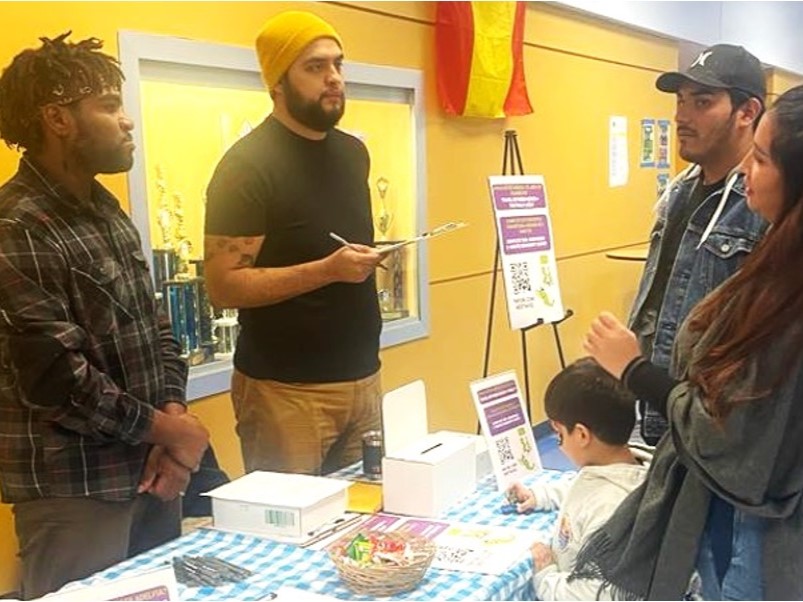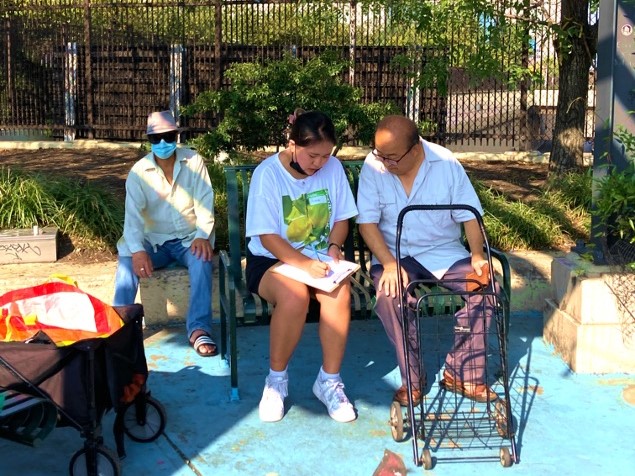
23 May Representation | Representación A Bilingual English/Spanish Blog Post Series
Welcome to our Bilingual English/Spanish Blog Post Series on Accessible Public Engagement!
A few days ago, a colleague approached me to talk about how to design a representative open house, particularly for the neighborhood where the event will be held, Chinatown. Inevitably we talk about Representation.
First, we evaluate the need to have professional interpreters; are they essential? It turns out that for this specific event, they are not since it’s more relevant to offer a space for attendees to feel at home and ask questions in a safe environment. Therefore, we’re prioritizing having people passionate about sharing a new project and opportunities to engage – this, while also being fluent in Mandarin and/or Cantonese. We also talked about the importance of creating culturally accessible spaces – such as semi-private rooms to have 1-on-1 conversations. The intention is that those who attend the event can participate actively and equally despite cultural differences.
In our previous post, we discussed language access and how this is not enough to say we have a culturally accessible public engagement process. What else is needed then? Going back to basics, cultural accessibility refers to ensuring that public engagement is usable by people from all cultural backgrounds. I use this experience to introduce us to the topic.
What is Representation and How to Achieve It
We hear a lot about racial and ethnic representation, as well as of people with physical limitations. However, representation is much more than finding yourself surrounded by people who look similar to you; It’s about feeling like you belong to the space where you are. It is about finding possibilities to participate actively and equally. For some, it is seeing people with facial features similar to their own, for others, it is finding people who share spiritual practices or who speak the same language.
So, how to have and communicate having a public engagement team that is representative of the public with whom you’re working? While some aspects are easily perceptible such as the language being spoken, others may not be as easily perceptible – as a spiritual practice. That’s when working with people already known in the neighborhood is invaluable.
Working hand in hand with public partners and leaders is an excellent way to not only have representation when conducting public engagement but also to make it known to the public. Additionally, you’ll have access to valuable information about the environment, such as knowing what other things are happening in the neighborhood.

Intercept survey conducted in Chinatown, Philadelphia in Fall 2022. Encuesta de interceptación realizada en Chinatown, Philadelphia en otoño de 2022.
Representation and Neighborhood Investment
It sounds great to work hand in hand with public partners and leaders, but it would be unfair to think that they will do it as volunteers. Investing in the neighborhood is a form of public relations that strengthens ties and trust. Here are some tips on how to do it:
-
- Clarify what is requested. To ensure alignment of expectations, clearly state what you expect the neighborhood partner to do. Whether distributing a pamphlet at their facility or giving a message at a meeting, clarify it and prepare materials they can use.
- Clarify the compensation. Now that you have defined what you will ask the neighborhood partner to do, identify fair compensation. This can be a stipend or an exchange of services (for example, training). Whatever the option is, make sure the compensation is fair.
- Flexibility in the way you compensate. Even if compensation is fair, some neighborhood partners or leaders may face limitations in receiving it. Whether it is the preference to receive payments only in cash or the infeasibility of traveling to a location to receive training. Always consider alternatives that are accessible to the people you are working with.
As a pro tip, don’t feel overwhelmed by not knowing the best way to invest in the locale or to compensate your neighborhood partners. Ask! If what you are concerned about is the budget, implement the practice of having a line of flexible expenses that allow you to respond to the needs of the population with which you are working.
How representative is your public engagement team of the neighborhooods they work with?
Like me, have you found a way to participate actively and equally in your locale or with your work team?
What would you like us to explore in upcoming posts on cultural accessibility?
Bienvenido(a/e) a nuestra serie bilingüe español/inglés sobre Relacionamiento Comunitario Inclusivo
Hace unos días, una compañera se acercó para platicar sobre cómo diseñar un evento estilo open-house que fuera inclusivo, particularmente para los vecinos del barrio en donde se va a realizar el evento: Chinatown. Claro que hablamos de Representación.
Primero evaluamos la necesidad de contar con intérpretes profesionales; ¿son esenciales? Resulta que para este evento en específico no lo son, ya que es más importante ofrecer un espacio para que los asistentes se sientan como en casa y hagan preguntas en un ambiente seguro. Por lo tanto, estamos dando prioridad a tener personas apasionadas por compartir un nuevo proyecto y oportunidades para participar -al tiempo que sean capaces de hablar mandarín y/o cantonés con fluidez. También hablamos sobre la importancia de crear espacios culturalmente accesibles, como salas semiprivadas para tener conversaciones uno a uno. La intención es que quienes asistan al evento puedan participar de forma activa y equitativa a pesar de diferencias culturales.
En nuestro post anterior discutimos sobre acceso lingüistico y cómo este no es suficiente para decir que tenemos un proceso de relacionamiento comunitario cultrualmente accesible. ¿Qué más es necesario? Recordando, accesibilidad cultural se refiere a garantizar que las formas de relacionamiento comunitario sean utilizables por personas de diversos orígenes culturales. Utilizo esta experiencia para introducirnos al tema.
Qué es la Representación y cómo lograrla
Mucho se escucha de representación racial y étnica, así como de personas con limitaciones físicas. Sin embargo, representación es mucho más que encontrarse rodeado de personas que ven parecidas a ti; se trata de sentirse perteneciente al espacio en donde se está. Se trata de encontrar posibilidades de participar activa e igualitariamente. Para algunos, es ver personas con razgos faciales similares a los priopios, para otros, es encontrar personas que comparten prácticas espirituales o que hablan el mismo idioma.
Entonces, ¿cómo lograr y comunicar que hay representación en mi equipo de relacionamiento comunitario? Si bien algunos aspectos son fácilmente perceptibles como el idioma que se habla, otros no pueden serlo tanto -como una práctica espiritual. Es ahí cuando trabajar con personas ya conocidas en la comunidad es invaluable.
Trabajar de la mano con socios comunitarios y líderes de la comunidad es una forma excelente de no solo tener representación al momento de realizar relacionamiento comunitario, sino también de hacerlo del conocimiento del público. Además, tendrás acceso a información valiosa del entorno, como el saber qué otras cosas están sucediendo en el vecindario.

Representación e inversión en la comunidad
Suena genial trabajar de la mano con socios comunitarios y líderes de la comunidad, pero sería injusto pensar que lo harán de manera gratuita. Invertir en la comunidad es una forma de relacionamiento comunitario que fortalece lazos y confianza. Aquí algunos consejos de cómo hacerlo:
-
- Claridad en lo que se pide. A fin de alinear expectativas, ten claramente por escrito qué esperas que realice el socio comunitario. Ya sea distribuir un panfleto en sus instalaciones o dar un mensaje en una reunión, clarifícalo y prepara materiales que ellos puedan utilizar.
- Claridad en la compensación. Ya que has definido lo que pedirás que el socio comunitario haga, identifica una compensación justa. Puede ser un estipendio o un intercambio de servicios (por ejemplo, una capacitación). Sea cual sea la opción, asegúrate de que la compensación sea justa.
- Flexibilidad en la forma de compensar. Aún y cuando la compensación sea justa, algunos socios comunitarios o líderes de la comunidad pueden enfrentar limitaciones para recibirla. Ya sea la preferencia a recibir pagos solo en efectivo o la inviabildiad de trasladarse a una locación para recibir una capacitación. Considera siempre alternativas que sean accessibles para las personas con las que estás trabajando.
Como pro tip, no te sientas intimidado por no saber cuál es la mejor forma de invertir en la comunidad o de compensar a tus socios comunitarios. ¡Pregunta! Y si lo que te preocupa es el presupuesto, implementa la práctica de tener una línea de gastos flexibles que te permitan responder a las necesidades de la comunidad con la que estás trabajando.
¿Qué tan representativo es tu equipo de relacionamiento comunitario respecto de las comunidades con las que trabajan?
Como yo, ¿has encontrado una forma de participar activa e igualitariamente en tu comunidad o con tu equipo de trabajo?
¿Qué te gustaría que exploremos en las próximas publicaciones sobre accesibilidad cultural?
 Sylvia es Directora en Connect the Dots. Altamente capacitada y con experiencia en gestión de impacto social en el sector privado, público y sin fines de lucro, tiene una Maestría en Prospectiva Estratégica por del Tec de Monterrey y una Licenciatura en Economía por la Universidad de Monterrey. Desde abril de 2022, Sylvia ha desempeñado un papel fundamental en las operaciones y los esfuerzos de relacionamiento comunitario inclusivo en Connect the Dots, gestionando proyectos clave, co-dirigiendo el desarrollo empresarial y supervisando la prestación eficiente de servicios. Apasionada por la inclusión, Sylvia tiene un certificado de posgrado en Liderazgo Sin Fines de Lucro y forma parte del Consejo Asesor de The Welcoming Center, promoviendo el crecimiento económico inclusivo para inmigrantes y refugiados, al tiempo que prioriza la construcción de relaciones y apoya el crecimiento de otros.
Sylvia es Directora en Connect the Dots. Altamente capacitada y con experiencia en gestión de impacto social en el sector privado, público y sin fines de lucro, tiene una Maestría en Prospectiva Estratégica por del Tec de Monterrey y una Licenciatura en Economía por la Universidad de Monterrey. Desde abril de 2022, Sylvia ha desempeñado un papel fundamental en las operaciones y los esfuerzos de relacionamiento comunitario inclusivo en Connect the Dots, gestionando proyectos clave, co-dirigiendo el desarrollo empresarial y supervisando la prestación eficiente de servicios. Apasionada por la inclusión, Sylvia tiene un certificado de posgrado en Liderazgo Sin Fines de Lucro y forma parte del Consejo Asesor de The Welcoming Center, promoviendo el crecimiento económico inclusivo para inmigrantes y refugiados, al tiempo que prioriza la construcción de relaciones y apoya el crecimiento de otros.
Sylvia is a highly skilled Principal at Connect the Dots, with expertise in private, public, and nonprofit social impact management, holding a Master’s degree in Strategic Thinking from Tec de Monterrey and a Bachelor’s degree in Economics from Universidad de Monterrey. Since April 2022, Sylvia has played a pivotal role in operations and accessible engagement at Connect the Dots, managing key projects, co-leading business development, and overseeing efficient service delivery. Passionate about representation, Sylvia holds a graduate certificate in Nonprofit Leadership and serves on the Advisory Council of The Welcoming Center, promoting representative economic growth for immigrants and refugees while prioritizing relationship-building and supporting others’ growth.
